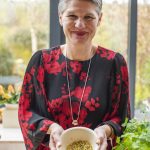Cultivating Fluency in the Language of Nature
Getty/ sarayut
"Let's find our creative flow as a part of nature, with food. "
Develop eco habits in the kitchen and tune into the rhythms of nature to access creative solutions to the climate crisis.
In 1968, speaking about social change as part of his campaign for U.S. presidential nomination,Robert F. Kennedy quoted George Bernard Shaw:“Some men see things as they are and ask why. I dream of things that never were, and ask why not.”
When I was an idealistic teenager with those words pinned on my wall, I thought the point was to dream up the “why nots.” Now, I think asking “why” is just as important. Both require creativity.
We live in an age called the Anthropocene, an epoch of human dominion over all other forms of life and the elements upon which we all depend, and that has resulted in climate change. Increasingly, we are becoming aware that economic, social, and environmental justice are interlinked.
It is a sign that our systems need to change and we have a whole lot of “why nots”to dream up. But if we want those “why nots” to help us create a regenerative world, one that is fair for all forms of life, we also have to look at why we adopted a mindset that caused all this mess in the first place.
Climate-change solutions are human solutions, and to find them, we all need to exercise our creativity. Exercising creativity makes you feel good. The Hungarian-American psychologist Mihaly Csikszentmihalyi, author of Creativity: The Psychology of Discovery and Invention, put it his way:
“Creativity is the central source of meaning in our lives . . . most of the things that are interesting, important, and human are the results of creativity . . . when we are involved in it, we feel that we are living more fully than during the rest of life.”
Let ́s find our creative flow as a part of nature, with food. (You might also enjoy "Unlock Your Creativity.")
Linking Environmental and Social Justice
Since World War II, the main food question we have asked is: How do we make more? The predominant answer to that question has been monocrop production, which requires breaking down diverse ecosystems to support the life of one species.
The problem is that all life is part of a web that thrives in relation to the life and death of other life-forms. So, in our pursuit of food security, we have made our food system insecure because we have broken down the ecosystem it relies on. The World Wildlife Fund ́s Living Planet Index indicates that our actions are hastening the extinction of other forms of live at an increasing rate.
Over the past fifty years, our collective destructive ecological footprint has increased by 190 percent. As in fashion, could less actually be more? In the 1980s, the Indian economist Amartya Sen won a Nobel Prize for his work revealing how food security is more about distribution than production.
Taking food that is produced for animal feed out the equation, each person on the earth has an allocation of about 2,800 calories per day from current production levels. Depending on your gender and activity levels, health guidelines recommend eating between 2,000 and 2,500 calories. We produce more than enough food to feed everyone in the world.
True food security lies in solutions that promote environmental and social justice and that require growing food regeneratively and wasting less of what we have. Creativity is the central source of meaning in our lives.
If “food waste” was a nation, it would be third to the United States and China in terms of greenhouse gas emissions. How do we stop? “Waste” is those things we don ́t perceive to be valuable. Increasing the value of food in our lives is the first step to changing our behavior. The more we learn about the food web, the more we realize that nothing exists in nature if it doesn ́t have value.
To appreciate the value of the food web, we have to look at it beyond the human perspective. There are creative approaches to increase the value of the food web in your eating life. Cultivate a beginner's mind with questions and rituals that help you tell new stories about yourself as nature. (For more on regenerative agriculture, read "Use Your Lawn to Fight Climate Change.")
Life itself is an act of creation.
Creativity Ritual with Nature: How to Read a Tree
There was a time when humans worshipped trees.
Considering that we couldn ́t breathe or eat were it not for trees, I think this is a reasonable world view. What can you learn about the value of food and nature from trees?
Pick a tree that you see on a regular basis and make a habit of paying attention to it. You will notice big things, perhaps the loss of its leaves before winter. What about the details?
- Do the leaves hang the same way morning, noon, and night?
- Does it produce fruit?
- Does the amount of fruit vary from year to year?
- Do certain animals live in the tree? If so, how is the relationship mutually beneficial? What about those elements you cannot see?
- Where do the tree’s roots run?
- How does that affect the soil?
Year in, year out, your tree is communicating with its environment and making decisions about how to live, depending on what changes around it. It becomes creative in order to adapt to its environment so that it can thrive. What can you learn from your tree about how food is connected to all of nature? Can you find any lessons on creative freedom, in treedom?


